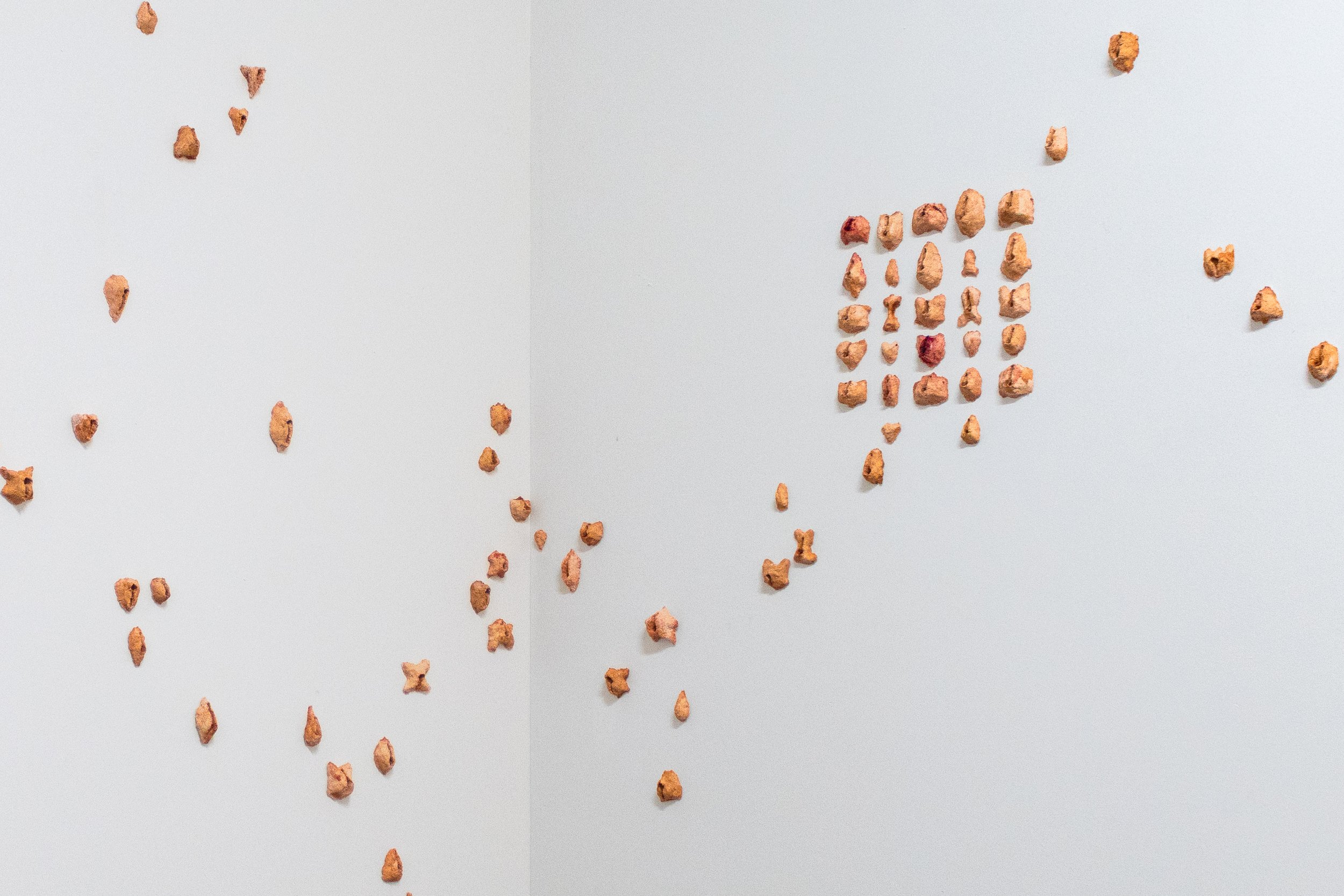Shuai Yang
(b.1998) New York based artist
Like Human But Not Human
Solo exhibition at Rockella Artist Program, 1639 Centre Street, Queens, New York
Like Human But Not Human - Exhibition Statement
In the ceremonial ritual of the Chu and Han Dynasty of Ancient China, people covered a coffin of the aristocracy with a T-shape painted banner. For being described as “like clothing but not clothing”, the banner is also called “non-clothing”. I borrowed the specious idea and named this exhibition Like Human But Not Human.
The exhibited works employ paper installations, reflective material, soil and video projection. They take various approaches to suggest the absent figure, examine the will of rebirth, and investigate the ideas of life cycles.
People from Chu and Han dynasties believed the ceremonial banner could either guide the soul of the dead to heaven or invite the soul to return to its physical flesh. At the center of the room, a long paper scroll hangs from the ceiling and lays down on the soil that spreads on the floor. The long scroll is dyed and made into a T-shape. It borrows the mysterious symbolism to investigate the perceptual understanding of rebirth and the physical form of the living people’s superego.
Connected by the soil and behind the paper scroll lays a mirror cut into the silhouette of my body in sleep. Next to the figure’s hand, a small round area of soil is removed, and the exposed floor becomes a surface for a video projection. Composition is a video that records the experience of looking at dust through a microscope. It projects to the “emptied floor,” visually suggesting the dust’s activities on the ground, inside the soil and in the air. “Dust to dust, earth to earth.” Aggregates of substance transform. Fine particles, although invisible, fill the void and are always in movement. They tell what we were before birth, and where we are going after this life.
Keep walking, the viewer will see intangible paper with simplified human-shape cut-outs connects the floor to the ceiling. A shorter T-shaped scroll suspends in the air, reveals silhouettes of the Gandhara fertility goddess in a repetitive pattern. The two paper works were ruffled to become fabric-looking. One carries the positive cut-outs; the other welcomes the viewer to observe the negative spaces, where the brick wall behind the paper discloses.
Following the paper dolls, some fleshy-colored sculptures bulge from the wall, leading the way to the space on the other side of the center installation. Hundreds of protrusions scatter from their initial template. The tiny sculptures are closely related to my work Womb. As residues of a paper doll template, they were unwanted in the previous design. Their rebirth denotes the viability of the abandonments. The repositioning of the protrusions- like the holes in them that suggest a threshold- indicates the state of transformation into another existence.
“似人非人”-展览序论
在中国楚汉时代的丧葬仪式里,贵族墓葬采用一种T形画帛覆盖棺椁。因有“似衣非衣”的形容,所以盖棺画帛也称作“非衣”。我借取“非衣”所含似是而非的意味,故而将本次展览命题为“似人非人”。
展览的作品以纸质装置、反射性材料、土壤、和视频为媒介,着重影射缺席的人物、探讨人对重生的期冀以及研究生命循环的理念。
楚汉时的人们相信丧葬画帛要么能带领灵魂找到天堂,或者能引导灵魂回归本来栖居的肉身。展陈空间中,一张染色长卷从天花板垂落,进入地上的土壤里。长卷以纸为媒材,制作成T形。我借用楚汉时期的神秘符号来探索人对于重生的感性认知,研究在世者的超我所呈现的物理形式。
长卷背后、以土壤连接的地方,躺着一面镜子,镜子的外形是我睡眠中的身体轮廓。在人像的手边,有一小片土壤经过移除,露出原本的水泥地面,使之成为视频投影的屏面。《构成》是一件影像作品,它记录通过显微镜观看尘埃移动的过程。影像投影到“空无的地板”上,以视觉的相似度来暗示观众留意地面上、土壤里和空气里的流动的颗粒物。“尘归尘,土归土”。物质的集合相互转化。小颗粒物虽然很难让人看见,但这些不断流动的尘埃实际上填充着虚空,讲述关于我们在出生前是什么和生命终结后又去哪里。
沿着土壤继续往深处走,观者会看见纸质的帘幕,它其中包含上千个呈简化人形的切口,从天花板一直蔓延到地面。另一张短尺寸的T形纸卷悬浮在空中,犍陀罗生育女神的剪影在重复的图案中显现。为了让这些纸质作品有织物的质感,我特意将其做成褶皱,再展开处理。这两件纸质作品一个用了“阳切”表现图案的正形,另一个相反,人形图案化为漏光的切口,让作品背后的砖墙给人物填充了颜色。
随纸人的走向,一些肉色的小雕塑从墙面突起来,引路到展览空间的另一侧,也是中央土堆装置的另一面。几百个突起物,自它们的模版处散开,这些小型雕塑与我的《子宫》系列作品紧密相关。它们作为上一组的纸人模版的废弃物,在此重生,暗示着舍弃物的生命力。对于突起物的重塑,就如同它们带有的象征临界点的洞口,指向演化为另一种存在形式的状态。



